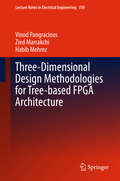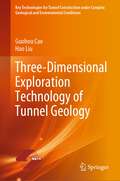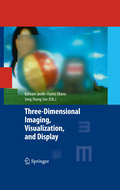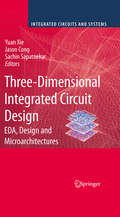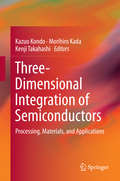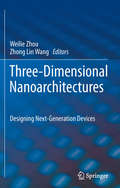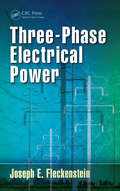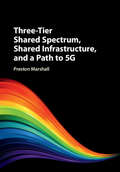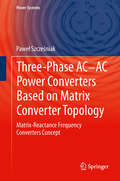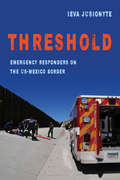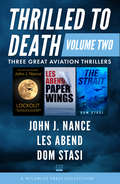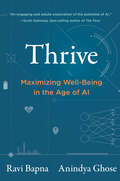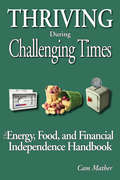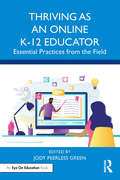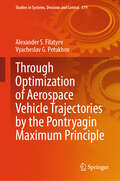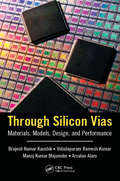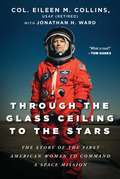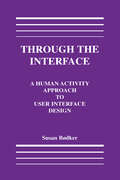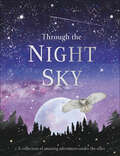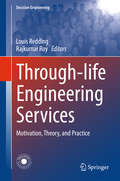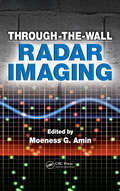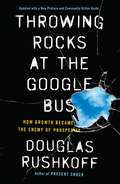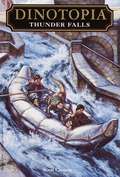- Table View
- List View
Three Things You Need to Know About Rockets: A Real-Life Scottish Fairy Tale
by Jessica A. FoxIn this inspiring, delightful memoir, a young woman decides to escape the daily grind and turn her "what if" fantasy into a reality, only to find work--and a man--she loves in one fell swoop, all in a secondhand bookstore in a quaint Scottish town.Jessica Fox was living in Hollywood, an ambitious 26-year-old film-maker with a high-stress job at NASA. Working late one night, craving another life, she was seized by a moment of inspiration and tapped "second hand bookshop Scotland" into Google. She clicked the first link she saw. A month later, she arrived 2,000 miles across the Atlantic in Wigtown, on the west coast of Scotland, and knocked on the door of the bookshop she would be living in for the next month . . . The rollercoaster journey that ensued--taking in Scottish Hanukkah, yoga on Galloway's west coast, and a waxing that she will never forget--would both break and mend her heart. It would also teach her that sometimes we must have the courage to travel the path less taken. Only then can we truly become the writers of our own stories.
Three-Dimensional Design Methodologies for Tree-based FPGA Architecture
by Vinod Pangracious Zied Marrakchi Habib MehrezThis book focuses on the development of 3D design and implementation methodologies for Tree-based FPGA architecture. It also stresses the needs for new and augmented 3D CAD tools to support designs such as, the design for 3D, to manufacture high performance 3D integrated circuits and reconfigurable FPGA-based systems. This book was written as a text that covers the foundations of 3D integrated system design and FPGA architecture design. It was written for the use in an elective or core course at the graduate level in field of Electrical Engineering, Computer Engineering and Doctoral Research programs. No previous background on 3D integration is required, nevertheless fundamental understanding of 2D CMOS VLSI design is required. It is assumed that reader has taken the core curriculum in Electrical Engineering or Computer Engineering, with courses like CMOS VLSI design, Digital System Design and Microelectronics Circuits being the most important. It is accessible for self-study by both senior students and professionals alike.
Three-Dimensional Exploration Technology of Tunnel Geology (Key Technologies for Tunnel Construction under Complex Geological and Environmental Conditions)
by Hao Liu Guohou CaoThis book gives a comprehensive introduction to the new geophysical detection theories, methods and technologies of tunnel engineering under complex geological conditions and environments. It mainly focuses on the application of 3D seismic technique, 3D high-power resistivity sounding, and 3D GPR, etc. There are 7 chapters in the book. Chapter 1 introduces the state of the art and developing trends of geophysical detection technologies for tunnel engineering. Chapter 2 analyzes the complex geological conditions and environments for tunnel construction and the latest geophysical detection technologies. Chapter 3 to Chapter 7 systematically elaborate on the 3D seismic techniques, 3D detection technologies for water content in tunnel surrounding rocks, 3D detection technologies for side/back slope, 3D detection technologies for shield tunneling, and 3D detection technologies for collapse treatment of tunnel construction. The book presents numerous case studies to illustrate the applications of these technologies.
Three-Dimensional Imaging, Visualization, and Display
by Bahram Javidi Fumio Okano Jung-Young SonThis book will describe recent developments, as well as the prospects and challenges facing 3D moving picture systems and devices, including binocular, multi-view, holographic, and image reproduction techniques. Optical systems, display instruments, and image capture techniques will be covered. The online supplement will include full color movies of experiments describing recent advances in 3D movies. This is the first state-of-the-art book on this subject that efficiently integrating the background material with new advances and applications and includes movies of 3D display systems.
Three-Dimensional Integrated Circuit Design
by Sachin Sapatnekar Yuan Xie Jingsheng Jason CongThis book provides the reader with a complete understanding of why three dimensional IC design is a promising solution to continue performance scaling, the possible ways to do 3D integration (fabrication), the EDA challenges and solutions to facilitate designers to do 3D IC design, the architectural benefits of using 3D technology, and the design issues at the architecture level. The work covers the background on 3D integration, fabrication options for 3D ICs, EDA flows and algorithms for 3D design, architecture level design techniques for 3D microarchitecture. The book includes an introduction on the background of 3D IC, a motivation that explains why the 3D IC is important and how it will trend, 3D process (fabrication) options, 3D EDA algorithms and tools (physical level and architectural level tools), 3D microarchitecture, including 3D FPGA, 3D single core/multi core processors, 3D Network-onchip designs.
Three-Dimensional Integration of Semiconductors
by Kazuo Kondo Morihiro Kada Kenji TakahashiThis book starts with background concerning three-dimensional integration - including their low energy consumption and high speed image processing - and then proceeds to how to construct them and which materials to use in particular situations. The book covers numerous applications, including next generation smart phones, driving assistance systems, capsule endoscopes, homing missiles, and many others. The book concludes with recent progress and developments in three dimensional packaging, as well as future prospects.
Three-Dimensional Nanoarchitectures
by Weilie Zhou Zhong Lin WangDevices built from three-dimensional nanoarchitectures offer a number of advantages over those based on thin-film technology, such as larger surface area to enhance the sensitivity of sensors, to collect more sunlight to improve the efficiency of solar cells, and to supply higher density emitters for increased resolution in flat panel displays. Three-dimensional nanoscale assembly has already been used to generate many prototypes of devices and sensors, including piezoelectric nanogenerators based on ZnO nanowire arrays, photovoltaic devices based on silicon nanowire array p-n junctions, and highly sensitive gas sensors based on metal oxide nanowire arrays among others. Three-Dimensional Nanoarchitectures: Designing Next-Generation Devices describes state-of-the-art synthesis, integration, and design strategies used to create three-dimensional nanoarchitectures for functional nanodevice applications. With a focus on synthesis and fabrication methods for three-dimensional nanostructure assembly and construction, coverage includes resonators, nanophotonics, sensors, supercapacitors, solar cells, and more. This book is an essential reference for a broad audience of researchers in materials science, chemistry, physics, and electrical engineering who want the latest information on synthesis routes and assembly methods. Schematics of device integration and mechanisms as well as plots of measurement data are included.
Three-Phase Electrical Power
by Joseph E. Fleckenstein<p>Three-Phase Electrical Power addresses all aspects of three-phase power circuits. The book treats the transmission of electrical power from the common sources where it is generated to locations where it is consumed. At typical facilities where electrical power is used, the book covers the important topics of grounding, currents, power, demand, metering, circuit protection, motors, motor protection, power factor correction, tariffs, electrical drawings, and relays. Included in the text are the necessary methods of computing currents and power in all possible types of circuit applications as those that are balanced, unbalanced, leading, lagging, three-wire, and four-wire. <p>Focusing on electrical gear, programs, and issues related to the generation and use of three-phase electrical power, this contemporary educational guide: <p> <li>Uses simple, straightforward language to explain key concepts and their underlying theory <li>Introduces numerous examples, illustrations, and photographs to aid in comprehension <li>Employs phasor concepts throughout the text to aid in the analysis of three-phase circuits <li>Encourages applied learning by supplying practical problems at the end of each chapter <li>Provides extensive references and a glossary of symbols, acronyms, and equations</li> <p> <p>Three-Phase Electrical Power delivers a much-needed modern-day treatment of three-phase electrical power for electrical engineering students and practitioners alike.</p>
Three-Tier Shared Spectrum, Shared Infrastructure, and a Path to 5G
by Preston MarshallWritten by a leading expert in the field, this unique book describes the technical requirements for three-tier shared spectrum as well as key policy rationale and the impact for 5G. Detail is provided on the inception of the concept and its implementation in the US Citizens Broadband Radio Service (CBRS), along with descriptions of standards for deployment, algorithms required for implementation, and the broader consequences for wireless network and service architectures. The economic and innovation incentives offered by three-tier spectrum are described, along with potential outcomes such as widely deployed neutral host networks. There is also detailed technical analysis of the unique challenges introduced by three-tier spectrum, such as co-existence among non-cooperating networks. Covering a wide range of spectrum bands, International Telecommunication Union (ITU) international allocations, and rule structures that can be adapted for different regimes, this is ideal for an international readership of communications engineers, policy-makers, regulators, and industry strategic planners.
Three-phase AC-AC Power Converters Based on Matrix Converter Topology
by Paweł SzcześniakAC voltage frequency changes is one of the most important functions of solid state power converters. The most desirable features in frequency converters are the ability to generate load voltages with arbitrary amplitude and frequency, sinusoidal currents and voltages waveforms; the possibility of providing unity power factor for any load; and, finally, a simple and compact power circuit. Over the past decades, a number of different frequency converter topologies have appeared in the literature, but only the converters with either a voltage or current DC link are commonly used in industrial applications. Improvements in power semiconductor switches over recent years have resulted in the development of many structures of AC-AC converters without DC electric energy storage. Such converters are an alternative solution for frequently recommended systems with DC energy storage and are characterized by a lower price, smaller size and longer lifetime. Most of the these topologies are based on the structure of the matrix converter. Three-Phase AC-AC Power Converters Based On Matrix Converter Topology: Matrix-reactance frequency converters concept presents a review of power frequency converters, with special attention paid to converters without DC energy storage. Particular attention is paid to nine new converters named matrix-reactance frequency converters which have been developed by the author and the team of researchers from Institute of Electrical Engineering at the University of Zielona Góra. The topologies of the presented matrix-reactance frequency converters are based on a three-phase unipolar buck-boost matrix-reactance chopper with source or load switches arranged as in a matrix converter. This kind of approach makes it possible to obtain an output voltage greater than the input one (similar to that in a matrix-reactance chopper) and a frequency conversion (similar to that in a matrix converter). Written for researchers and Ph.D. students working in the field of power electronics converters and drive systems, Three-Phase AC-AC Power Converters Based On Matrix Converter Topology: Matrix-reactance frequency converters concept will also be valuable to power electronics converter designers and users; R&D centers; and readers needing industry solutions in variable speed drive systems, such as automation and aviation.
Threshold: Emergency Responders On The U.S. - Mexico Border
by Ieva JusionyteEmergency responders on the US-Mexico border operate at the edges of two states. They rush patients to hospitals across country lines, tend to the broken bones of migrants who jump over the wall, and put out fires that know no national boundaries. Paramedics and firefighters on both sides of the border are tasked with saving lives and preventing disasters in the harsh terrain at the center of divisive national debates. <P><P> Ieva Jusionyte’s firsthand experience as an emergency responder provides the background for her gripping examination of the politics of injury and rescue in the militarized region surrounding the US-Mexico border. Operating in this area, firefighters and paramedics are torn between their mandate as frontline state actors and their responsibility as professional rescuers, between the limits of law and pull of ethics. From this vantage they witness what unfolds when territorial sovereignty, tactical infrastructure, and the natural environment collide. Jusionyte reveals the binational brotherhood that forms in this crucible to stand in the way of catastrophe. Through beautiful ethnography and a uniquely personal perspective, Threshold provides a new way to understand politicized issues ranging from border security and undocumented migration to public access to healthcare today.
Thrilled to Death Volume Two: Lookout, Paper Wings, and The Strait (Thrilled to Death)
by John J. Nance Les Abend Dom StasiBuckle your seatbelts for three high-flying aviation thrillers—written by experienced pilots including a New York Times–bestselling author. Lockout Whoever has electronically disconnected the flight controls of Pangia Flight 10 as it streaks toward the volatile Middle East may be trying to provoke a nuclear war. With time and fuel running out, the pilots are forced to put animosities aside and risk everything to wrest control from the electronic ghost holding them on a course to disaster. &“A wild ride through the night sky.&” —Capt. &“Sully&” Sullenberger, #1 New York Times–bestselling author Paper Wings When a boat is found adrift off Fort Lauderdale, the investigation leads to more than murder—the evidence points to an &“accident&” that downed a passenger jet in Bermuda. Capt. Hart Lindy&’s role in the NTSB investigation puts him on a flight path to danger trying to determine what really happened to Flight 63. &“A masterful melange of deadly mysteries and desperate acts.&” —John J. Nance, New York Times–bestselling authorThe Strait Upon learning that Swede Bergstrom, the hero who saved his life, has been killed during the commission of a crime, pilot Jake Silver agrees to follow Swede&’s mysterious and beautiful sister, Christina, on a search to clear her brother&’s name. Their odyssey will take them into the heart of darkness itself, dodging death every step of the way . . . &“The Strait interrupted my normal sleep cycle . . . a page-turner for sure.&” —Donald J. Porter, aviation historian and author of Flight Failure
Thrive: Maximizing Well-Being in the Age of AI
by Anindya Ghose Ravi BapnaHow AI can positively impact so many aspects of our daily lives, from health and wellness to work, education, and home life.Artificial intelligence (AI) is a powerful general-purpose technology that is reshaping the modern economy, but misperceptions about AI stand in the way of harnessing it for the betterment of humanity. In Thrive, Ravi Bapna and Anindya Ghose counter the backlash by showcasing how AI is positively influencing the aspects of our daily lives that we care about most: our health and wellness, relationships, education, the workplace, and domestic life. In the process the authors help explain the underlying technology and give people the agency they need to shape the debate around how we should regulate AI to maximize its benefits and minimize its risks.Bringing over two decades of experience with cutting-edge research, consulting, executive coaching, and advising to bear on the subject, Bapna and Ghose demystify the technology of AI itself. They offer a novel &“House of AI&” framework that encompasses traditional analytics, generative AI, and fair and ethical deployment of AI. Using examples from everyday life, they showcase how the modern AI-powered ecosystem fundamentally improves the emotional, physical, and material well-being of regular people across the globe. Thrive&’s mission is to educate the public about AI, shape realistic expectations, and foster informed discussions about a fast-emerging AI-shaped society.
Thriving During Challenging Times
by Cam MatherMost of us have never lived through times as tough as these. The economic crisis, peak oil, rising food costs, climate change, and water shortages have all converged to make it a very challenging time. This book provides a road map to allow you to return to the independence of previous generations: independence in how you power your home, where you get your food from, and how you control your financial destiny. The amazing thing is that the recommendations are not only good for you, they're good for the planet. Showering with water heated by the sun and eating a "one hundred foot diet" with food grown in your backyard will help you to reduce your carbon footprint. They also give you back control of your budget. By using the step-by-step guide on how to get the fastest payback and invest the money you save, you'll discover the joy of being in control again.From where you live, to how you heat and power your home, to producing your own food, controlling water, and getting your financial house in order, this book proves that money doesn't buy happiness, but using what you have wisely helps.Because most of the recommendations are good for your health, good for the health of the planet, and good for your finances, the book sets out a win/win/win scenario. Challenging times provide a tremendous opportunity for personal growth while giving your soul the joy to return to a saner pace in your life.
Thriving as an Online K-12 Educator: Essential Practices from the Field
by Jody Peerless GreenThriving as an Online K-12 Educator is the perfect all-in-one guide to taking your K-12 class online. We know, now more than ever, that teachers have not been equally or systematically trained and resourced to make a sudden transition to online or blended instruction. This concise, accessible book collects time-tested strategies and fresh perspectives from experienced educators to help you smooth out even the most abrupt shift to technology-enhanced teaching and learning. With these insights into institutional supports, effective digital tools, equitable practice, social-emotional considerations, and beyond, you will be better prepared than ever to help your students thrive in online and blended learning environments.
Thriving on Our Changing Planet: A Decadal Strategy For Earth Observation From Space
by Engineering Medicine National Academies of SciencesWe live on a dynamic Earth shaped by both natural processes and the impacts of humans on their environment. It is in our collective interest to observe and understand our planet, and to predict future behavior to the extent possible, in order to effectively manage resources, successfully respond to threats from natural and human-induced environmental change, and capitalize on the opportunities – social, economic, security, and more – that such knowledge can bring. By continuously monitoring and exploring Earth, developing a deep understanding of its evolving behavior, and characterizing the processes that shape and reshape the environment in which we live, we not only advance knowledge and basic discovery about our planet, but we further develop the foundation upon which benefits to society are built. Thriving on Our Changing Planet presents prioritized science, applications, and observations, along with related strategic and programmatic guidance, to support the U.S. civil space Earth observation program over the coming decade.
Through Optimization of Aerospace Vehicle Trajectories by the Pontryagin Maximum Principle (Studies in Systems, Decision and Control #579)
by Alexander S. Filatyev Vyacheslav G. PetukhovThis monograph investigates the trajectory optimization problems of low- and finite-thrust aerospace vehicles and spacecraft using an indirect method based on the Pontryagin maximum principle, providing a methodological basis for the construction of numerical techniques that are superior in versatility and accuracy to direct methods. This book provides a theoretical explanation of the approaches used and also an extensive gallery of the results of practical numerical studies. The problem of boundary value problem convergence has been largely overcome, which has made it possible to practically automate the optimization of trajectories and to achieve a qualitative generalization with a number of fundamentally new results. Examples of practical optimization of branching trajectories of complex dynamics systems with finite and continual sets of branches, in deterministic and stochastic statements, with control constraints and phase constraints of various orders are demonstrated. An emphasis is placed on the consistent application of methods of numerical continuation with respect to a parameter to solve various problems in the flight mechanics of spacecraft with an electric propulsion system (EPS). The problems considered include the optimization of direct interplanetary flights of spacecraft with thrusters having limited power or limited thrust, of interplanetary flights of such spacecraft using gravity assisted maneuvers, of multi-orbit interorbital transfers of spacecraft with limited-thrust EPS. As a result, it was possible to develop a set of numerical continuation methods for solving a wide range of optimization problems for spacecraft trajectories with EPS with improved characteristics in terms of convergence and performance. This monograph also contains a description of many pitfalls in solving a wide range of problems of optimizing the trajectories of aerospace vehicles and recipes for effectively overcoming them.
Through Silicon Vias: Materials, Models, Design, and Performance
by Brajesh Kumar Kaushik Manoj Kumar Majumder Vobulapuram Ramesh Kumar Arsalan AlamRecent advances in semiconductor technology offer vertical interconnect access (via) that extend through silicon, popularly known as through silicon via (TSV). This book provides a comprehensive review of the theory behind TSVs while covering most recent advancements in materials, models and designs. Furthermore, depending on the geometry and physical configurations, different electrical equivalent models for Cu, carbon nanotube (CNT) and graphene nanoribbon (GNR) based TSVs are presented. Based on the electrical equivalent models the performance comparison among the Cu, CNT and GNR based TSVs are also discussed.
Through the Glass Ceiling to the Stars: The Story of the First American Woman to Command a Space Mission
by Jonathan H. Ward Col. Eileen M. Collins UsafThe long-awaited memoir of a trailblazer and role model who is telling her story for the first time. <p><p> Eileen Collins was an aviation pioneer her entire career, from her crowning achievements as the first woman to command an American space mission as well as the first to pilot the space shuttle to her early years as one of the Air Force's first female pilots. She was in the first class of women to earn pilot's wings at Vance Air Force Base and was their first female instructor pilot. She was only the second woman pilot admitted to the Air Force's elite Test Pilot Program at Edwards Air Force Base. NASA had such confidence in her skills as a leader and pilot that she was entrusted to command the first shuttle mission after the Columbia disaster, returning the US to spaceflight after a two-year hiatus. Since retiring from the Air Force and NASA, she has served on numerous corporate boards and is an inspirational speaker about space exploration and leadership. <p><p> Eileen Collins is among the most recognized and admired women in the world, yet this is the first time she has told her story in a book. It is a story not only of achievement and overcoming obstacles but of profound personal transformation. The shy, quiet child of an alcoholic father and struggling single mother, who grew up in modest circumstances and was an unremarkable student, she had few prospects when she graduated from high school, but she changed her life to pursue her secret dream of becoming an astronaut. She shares her leadership and life lessons throughout the book with the aim of inspiring and passing on her legacy to a new generation.
Through the Interface: A Human Activity Approach To User Interface Design
by Susanne BodkerIn providing a theoretical framework for understanding human- computer interaction as well as design of user interfaces, this book combines elements of anthropology, psychology, cognitive science, software engineering, and computer science. The framework examines the everyday work practices of users when analyzing and designing computer applications. The text advocates the unique theory that computer application design is fundamentally a collective activity in which the various practices of the participants meet in a process of mutual learning.
Through the Night Sky: A collection of amazing adventures under the stars (Journey Through)
by DKA beautifully illustrated collection of nonfiction stories featuring the many wonders that exist in the night sky.Beginning with a sunset and ending at dawn, Through the Night Sky shines a light on the magical events taking place in the darkness above. Unlike an astronomy book that focuses on eye-popping facts and figures about the universe, Through the Night Sky features a series of incredible stories that take place in the sky at night. Track a colony of bats as they fly through the twilight to pollinate the flowers of the mysterious baobab tree, follow a family into the wilderness to gaze at the constellations, watch whales swimming through chilly Arctic waters under the gentle glow of the Northern Lights, then chart the journey of a ship navigating by the stars. Through the Night Sky is a beautiful book that spans a wide range of subjects, including everything from nocturnal animals or revelers watching fireworks illuminate the night, to celestial objects such as the moon, planets, stars, and meteor showers--all under the vast night sky.
Through-life Engineering Services
by Louis Redding Rajkumar RoyDemonstrating the latest research and analysis in the area of through-life engineering services (TES), this book utilizes case studies and expert analysis from an international array of practitioners and researchers - who together represent multiple manufacturing sectors: aerospace, railway and automotive - to maximize reader insights into the field of through-life engineering services. As part of the EPSRC Centre in Through-life Engineering Services program to support the academic and industrial community, this book presents an overview of non-destructive testing techniques and applications and provides the reader with the information needed to assess degradation and possible automation of through-life engineering service activities . The latest developments in maintenance-repair-overhaul (MRO) are presented with emphasis on cleaning technologies, repair and overhaul approaches and planning and digital assistance. The impact of these technologies on sustainable enterprises is also analyzed. This book will help to support the existing TES community and will provide future studies with a strong base from which to analyze and apply techn9olgical trends to real world examples.
Through-the-Wall Radar Imaging
by Moeness G. AminThrough-the-wall radar imaging (TWRI) allows police, fire and rescue personnel, first responders, and defense forces to detect, identify, classify, and track the whereabouts of humans and moving objects. Electromagnetic waves are considered the most effective at achieving this objective, yet advances in this multi-faceted and multi-disciplinary technology require taking phenomenological issues into consideration and must be based on a solid understanding of the intricacies of EM wave interactions with interior and exterior objects and structures. Providing a broad overview of the myriad factors involved, namely size, weight, mobility, acquisition time, aperture distribution, power, bandwidth, standoff distance, and, most importantly, reliable performance and delivery of accurate information, Through-the-Wall Radar Imaging examines this technology from the algorithmic, modeling, experimentation, and system design perspectives. It begins with coverage of the electromagnetic properties of walls and building materials, and discusses techniques in the design of antenna elements and array configurations, beamforming concepts and issues, and the use of antenna array with collocated and distributed apertures. Detailed chapters discuss several suitable waveforms inverse scattering approaches and revolve around the relevance of physical-based model approaches in TWRI along with theoretical and experimental research in 3D building tomography using microwave remote sensing, high-frequency asymptotic modeling methods, synthetic aperture radar (SAR) techniques, impulse radars, airborne radar imaging of multi-floor buildings strategies for target detection, and detection of concealed targets. The book concludes with a discussion of how the Doppler principle can be used to measure motion at a very fine level of detail. The book provides a deep understanding of the challenges of TWRI, stressing its multidisciplinary and phenomenological nature. The breadth and depth of topics covered presents a highly detailed treatment of this potentially life-saving technology.
Throwing Rocks at the Google Bus
by Douglas RushkoffWhy doesn't the explosive growth of companies like Facebook and Uber deliver more prosperity for everyone? What is the systemic problem that sets the rich against the poor and the technologists against everybody else? When protesters shattered the windows of a bus carrying Google employees to work, their anger may have been justifiable, but it was misdirected. The true conflict of our age isn't between the unemployed and the digital elite, or even the 99 percent and the 1 percent. Rather, a tornado of technological improvements has spun our economic program out of control, and humanity as a whole--the pro-testers and the Google employees as well as the shareholders and the executives--are all trapped by the consequences. It's time to optimize our economy for the human beings it's supposed to be serving. In this groundbreaking book, acclaimed media scholar and author Douglas Rushkoff tells us how to combine the best of human nature with the best of modern technology. Tying together disparate threads--big data, the rise of robots and AI, the increasing participation of algorithms in stock market trading, the gig economy, the collapse of the eurozone--Rushkoff provides a critical vocabulary for our economic moment and a nuanced portrait of humans and commerce at a critical crossroads.From the Hardcover edition.
Thunder Falls (Dinotopia Series)
by Scott CiencinTwo young dinosaurs learn the value of cooperation when they are sent on a quest for a hidden prize.

